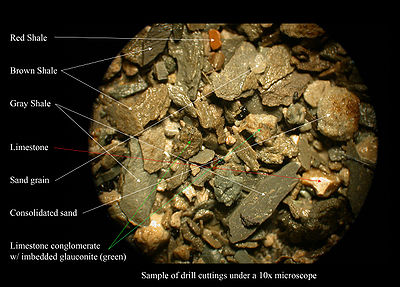- Drill cuttings
-
Drill cuttings[1] are the broken bits of solid material removed from a borehole drilled by rotary, percussion, or auger methods. Boreholes drilled in this way include oil or gas wells, water wells, and holes drilled for geotechnical investigations or mineral exploration.
The drill cuttings are commonly examined to make a record (a well log) of the subsurface materials penetrated at various depths. In the oil industry, this is often called a mud log.
Drill cuttings are produced as the rock is broken by the drill bit advancing through the rock or soil; the cuttings are usually carried to the surface by drilling fluid circulating up from the drill bit. Drill cuttings are separated from the drilling fluid by shale shakers (for liquid drilling fluid), or by cyclone separators (for air drilling). In cable-tool drilling, the drill cuttings are periodically bailed out of the bottom of the hole. In auger drilling, cuttings are carried to the surface on the auger flights.
One drilling method that does not produce drill cuttings is core drilling, which instead instead produces solid cylinders of rock or soil.
References
- ^ http://www.glossary.oilfield.slb.com/Display.cfm?Term=cuttings Schlumberger: Oilfield Glossary
Categories:
Wikimedia Foundation. 2010.

